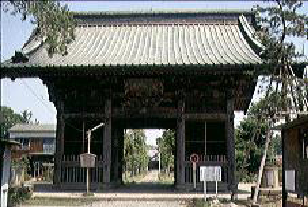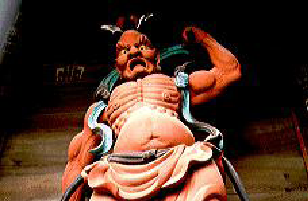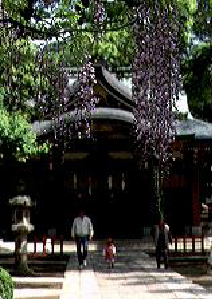Daishoji Temple
 Daishoji Temple was built in 750, and is located in the Koshigaya City's Osagami area. It is widely known as “Osagami Fudo.” The temple's gate is about 200 years old, and displays a tablet that was handwritten by Sadanobu Matsudaira, a senior official in the Tokugawa Shogunate
Daishoji Temple was built in 750, and is located in the Koshigaya City's Osagami area. It is widely known as “Osagami Fudo.” The temple's gate is about 200 years old, and displays a tablet that was handwritten by Sadanobu Matsudaira, a senior official in the Tokugawa Shogunate

. The gate’s roof was originally covered in clay tiles, but is now covered in copper ones. Also, the temple’s grounds contain a magnificent Tabunoki, an evergreen tree of the Lauraceae family. The Tabunoki is about 500 years old, is about 8 meters tall, and has a trunk 4 meters in circumference.
Temple Gate Nio Statue - Part of the Temple Gate
Among the temples historical relics are the “Akatsuki No Negoromo,” which are bedclothes used by the first Tokugawa Shogun, Ieyasu Tokugawa, and a document called the “Ujishige Hojo Okitegaki.” This document was written by Ujishige Hojo of the powerful Hojo family, and is the oldest written document existing in Koshigaya.
Koshigaya Hisaizu Shrine
 It is uncertain when the Koshigaya Hisaizu Shrine was built, but it is said to house the main guardian deity of the Koshigaya area, and contains a prefectural natural treasure and a prefectural cultural treasure in its grounds. The natural treasure is a wisteria plant that is about 200 years old, and the cultural treasure is the residence where the influential Shinto scholar, Atsutane Hirata lived for a time. An ema, a votive picture tablet, dedicated by Hirata, is also kept at the shrine. The shrine’s grounds contain a kuhi, a stone tablet inscribed with a haiku, bearing a poem composed by Gozan Koshigaya, who was a literary figure born in Koshigaya, and the is acknowledged as the originator of Japanese dialectology. Also, the grove within the shrine’s grounds contains many Japanese cypress and zelkova trees, as well as many sudajii, which is a type of chinquapin.
It is uncertain when the Koshigaya Hisaizu Shrine was built, but it is said to house the main guardian deity of the Koshigaya area, and contains a prefectural natural treasure and a prefectural cultural treasure in its grounds. The natural treasure is a wisteria plant that is about 200 years old, and the cultural treasure is the residence where the influential Shinto scholar, Atsutane Hirata lived for a time. An ema, a votive picture tablet, dedicated by Hirata, is also kept at the shrine. The shrine’s grounds contain a kuhi, a stone tablet inscribed with a haiku, bearing a poem composed by Gozan Koshigaya, who was a literary figure born in Koshigaya, and the is acknowledged as the originator of Japanese dialectology. Also, the grove within the shrine’s grounds contains many Japanese cypress and zelkova trees, as well as many sudajii, which is a type of chinquapin.
Wisteria and the Koshigaya Hisaizu Shrine
Mitakata Iseki Ruins
 The Mitakata Ruins are located on the northern side of the Japan Rail - Musashino Line in Koshigaya City’s Osagami area, and date from the later part of the Tumulus period (250 - 552). During archeological excavations carried out in 1966 and 1967, two housing sites and an enigmatic ditch were found. Again, the ruins have yielded earthenware vessels, tools for spinning thread, fishing sinkers, building materials, wooden items such as food vessels, and pieces of stone shaped as weapons, ceremonial items and tools for use in daily life. These artifacts suggest that the people living in Koshigaya in the Tumulus Period spun thread, caught fish, and cultivated rice. Again, as some of these artifacts are made from stone that is not found in the Koshigaya area, it is thought that trade between the people living in Koshigaya and in other areas may have taken place. A number of these artifacts are exhibited in the first floor lobby of the Koshigaya City Library.
The Mitakata Ruins are located on the northern side of the Japan Rail - Musashino Line in Koshigaya City’s Osagami area, and date from the later part of the Tumulus period (250 - 552). During archeological excavations carried out in 1966 and 1967, two housing sites and an enigmatic ditch were found. Again, the ruins have yielded earthenware vessels, tools for spinning thread, fishing sinkers, building materials, wooden items such as food vessels, and pieces of stone shaped as weapons, ceremonial items and tools for use in daily life. These artifacts suggest that the people living in Koshigaya in the Tumulus Period spun thread, caught fish, and cultivated rice. Again, as some of these artifacts are made from stone that is not found in the Koshigaya area, it is thought that trade between the people living in Koshigaya and in other areas may have taken place. A number of these artifacts are exhibited in the first floor lobby of the Koshigaya City Library.
Reconstructed Tumulus Period House
Buddhist Images Created by Enku
 Buddhist images created by Enku, an itinerant sculptor-priest, can be seen at the Ankokuji, Seifuku-In and Kofuku-In Temples in Koshigaya. There are three Buddhist images created by Enku at the Ankokuji Temple; a main image made from excess building material, and two smaller images made from paulownia located on each side of the main image. Enku’s Buddhist images at the Seifuku-In Temple also consist of a main image, with two smaller images on located on each side of the main one. However, all three are made from Japanese cedar. There is one Buddhist image created by Enku at the Kofuku-in Temple. Enku was born in Mino No Kuni (now Gifu Prefecture) in around 1630, and after becoming a Buddhist priest, spent most of his life traveling throughout Japan. He is said to have created about 120,000 Buddhist images during his travels, and about 130 of his works exist in Saitama Prefecture. It is thought that he created these when passing through what is now Saitama Prefecture on his way to Nikko in 1689.
Buddhist images created by Enku, an itinerant sculptor-priest, can be seen at the Ankokuji, Seifuku-In and Kofuku-In Temples in Koshigaya. There are three Buddhist images created by Enku at the Ankokuji Temple; a main image made from excess building material, and two smaller images made from paulownia located on each side of the main image. Enku’s Buddhist images at the Seifuku-In Temple also consist of a main image, with two smaller images on located on each side of the main one. However, all three are made from Japanese cedar. There is one Buddhist image created by Enku at the Kofuku-in Temple. Enku was born in Mino No Kuni (now Gifu Prefecture) in around 1630, and after becoming a Buddhist priest, spent most of his life traveling throughout Japan. He is said to have created about 120,000 Buddhist images during his travels, and about 130 of his works exist in Saitama Prefecture. It is thought that he created these when passing through what is now Saitama Prefecture on his way to Nikko in 1689.
Buddhist Image at the Ankokuji Temple
